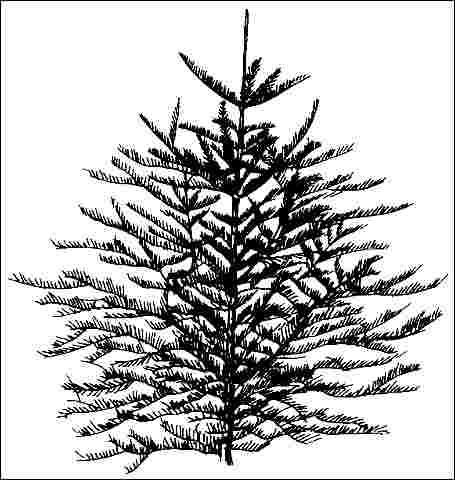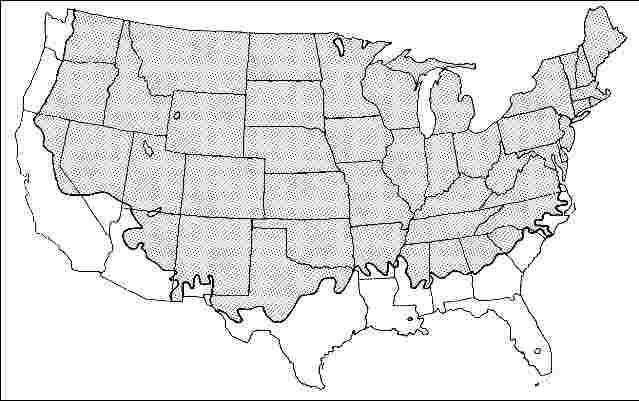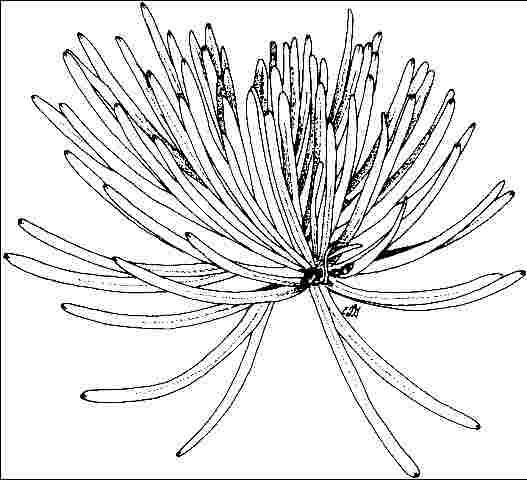Introduction
One of the best firs for the east, white fir reaches a mature height of 75 feet or more but is often much smaller in the landscape, 40 to 50 feet. It has a pyramidal shape and horizontal branching with the lower branches drooping toward the ground. It makes an outstanding specimen, so the tree should be grown in an open area so the lower branches can touch the ground. When branched to the ground, Colorado white fir will cast dense shade, which kills turf grass. The foliage is a wonderful silver-blue that appears much like that of the Colorado blue spruce. White fir may grow one and one-half feet per year with good growing conditions. This tree can take exposure and will withstand heat and drought better than most firs. Abies firma is much more heat-tolerant, has green glossy foliage, and grows even further south into USDA hardiness zone 8.

Credit: UF/IFAS
General Information
Scientific name: Abies concolor
Pronunciation: AY-beez KAWN-kull-er
Common name(s): Colorado white fir
Family: Pinaceae
USDA hardiness zones: 3A through 7B (Figure 2)
Origin: native to North America
UF/IFAS Invasive Assessment Status: not assessed/incomplete assessment
Uses: Christmas tree; highway median; screen; specimen; Bonsai

Credit:
Description
Height: 40 to 50 feet
Spread: 15 to 25 feet
Crown uniformity: symmetrical
Crown shape: pyramidal
Crown density: moderate
Growth rate: slow
Texture: fine
Foliage
Leaf arrangement: spiral (Figure 3)
Leaf type: simple
Leaf margin: entire
Leaf shape: needle-like (filiform)
Leaf venation: parallel
Leaf type and persistence: evergreen, needled evergreen
Leaf blade length: less than 2 inches
Leaf color: silver
Fall color: no color change
Fall characteristic: not showy

Credit: UF/IFAS
Flower
Flower color: red
Flower characteristics: not showy
Fruit
Fruit shape: cone, elongated
Fruit length: 3 to 6 inches
Fruit covering: dry or hard
Fruit color: brown
Fruit characteristics: does not attract wildlife; not showy; fruit/leaves not a litter problem
Trunk and Branches
Trunk/bark/branches: branches droop; not showy; typically one trunk; thorns
Pruning requirement: little required
Breakage: resistant
Current year twig color: green
Current year twig thickness: medium
Wood specific gravity: 0.39
Culture
Light requirement: partial sun or partial shade, full sun
Soil tolerances: clay; sand; loam; acidic; well-drained
Drought tolerance: high
Aerosol salt tolerance: none
Other
Roots: not a problem
Winter interest: no
Outstanding tree: yes
Invasive potential: little invasive potential
Ozone sensitivity: unknown
Verticillium wilt susceptibility: resistant
Pest resistance: resistant to pests/diseases
Use and Management
White fir transplants well balled-and-burlapped, if properly root-pruned; otherwise, it will be hard to transplant. The tree prefers a moist, well-drained loam and dislikes heavy clay or high pH soils. The root system can adapt to wet or rocky soil conditions by growing close to the surface of the soil. It will not tolerate clay or constantly wet soil. As a Christmas tree, white fir remains fresh and retains its needles for two weeks or more if provided with water. Colorado white fir is an excellent substitute for the disease-sensitive Colorado blue spruce, since it is less prone to diseases.
Unfortunately, white fir is rare in the horticultural trade, but it should be grown and used more often. Other cultivars include ‘Conica’, which is more dwarf and conically-shaped, and ‘Compacta’, a slow-growing dwarf fir.
Pests
Generally, no pests are serious, but some cause minor damage. The balsam twig aphid feeds on the new growth of fir, causing distorted needles and deposits of honeydew. Trees can tolerate fairly heavy infestations for a short period of time but are weakened by repeated heavy infestations.
Bagworm builds and lives in a two- to three-inch long sack built from needles and other debris. The insect overwinters as eggs in the sacks of the female. Control by hand-picking the bags in winter.
The more common scale insects infesting fir are oystershell, pine needle, and cottony cushion. These insects are hard to control once inside their shell or waxy coatings. The crawler stage is most easily controlled with appropriate pesticides.
Spider mites in hot areas cause older needles to lose green coloration and become yellowed. The insects are very small and difficult to see, so infestations can become severe before being noticed. This is perhaps the most common problem.
Diseases
Generally, none are serious enough to cause concern. Needle and twig blight results in the shriveling and reddening of the new growth. The needles of current seasons growth are curled and dead. Terminal growth and some laterals may be killed.
Pine twig blight is a problem on stressed trees. The fungus will not ordinarily be a problem unless the host plant is weakened. The infection usually begins at the terminal bud near a branch tip. Infection takes place in late summer and the disease progresses down a twig into a node. At times the infection may go into two-year-old wood. Needles on infected branches turn reddish and then die. Cut off and destroy infected twigs.
Several rusts attack firs but are not a problem on landscape trees. The diseases are rarely seen.
Several different fungi cause cankers on the trunks and branches of firs. Cankers are sunken areas in the bark that gradually get larger. When the stem is completely encircled, the part beyond the canker dies. Keep the plants healthy by fertilizing and watering during dry weather. Cankers can be largely prevented by avoiding plant injury.
Root rots caused by several fungi kill roots and rot wood. Little can be done to control the diseases other than to keep trees healthy to prevent disease infection. Maintain tree health by regular fertilization and watering during dry weather.